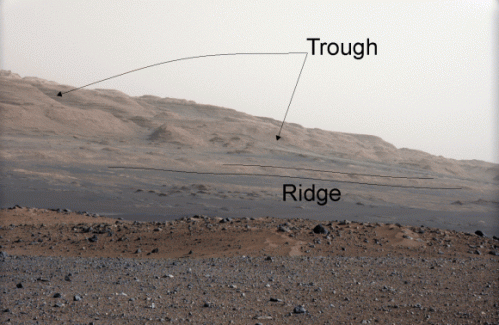Was this ridge habitable? Mars Curiosity eyes nearby mountain

So Curiosity has been on Mars for an Earth year and is now, slowly, making its way over to that ginormous mountain—Mount Sharp, or Aeolis Mons—in the distance. The trek is expected to take at least until mid-2014, if not longer, because the rover will make pit stops at interesting science sites along the way. But far-thinking scientists are already thinking about what areas they would like to examine when it gets there.
One of those is an area that appears to have formed in water. There's a low ridge on the bottom of the mountain that likely includes hematite, a mineral that other Mars rovers have found. (Remember the "blueberries" spotted a few years ago?) Hematite is an iron mineral that comes to be "in association with water", a new study reports, and could point the way to the habitable conditions Curiosity is seeking.
The rub is scientists can't say for sure how the hematite formed until the rover is practically right next to the ridge. There are plenty of pictures from orbit, but not high-resolution enough for the team to make definitive answers.
"Two alternatives are likely: chemical precipitation within the rocks by underground water that became exposed to an oxidizing environment—or weathering by neutral to slightly acidic water," wrote Arizona State University's Red Planet Report. Either way, it shows the ridge likely hosted iron oxidation. Earth's experience with this type of oxidation shows that it happens "almost exclusively" with microorganisms, but that's not a guarantee on Mars.
Mars Reconnaissance Orbiter images show that the ridge is about 660 feet (200 meters) wide and four miles (6.5 kilometers) long, with strata or layers in the ridge appearing to be similar to those of layers in Mount Sharp.
While Curiosity is not designed to seek life, it can ferret out details of the environment. Just a few weeks ago, for example, it uncovered pebbles that likely formed in the presence of water. Other Mars missions have also found evidence of that liquid, with perhaps some of it once arising from the subsurface. Where the water came from, and why the environment of Mars changed so much in the last few billion years, are ongoing scientific questions.
Check out more details on the study in Geology.
Journal information: Geology
Source: Universe Today





















